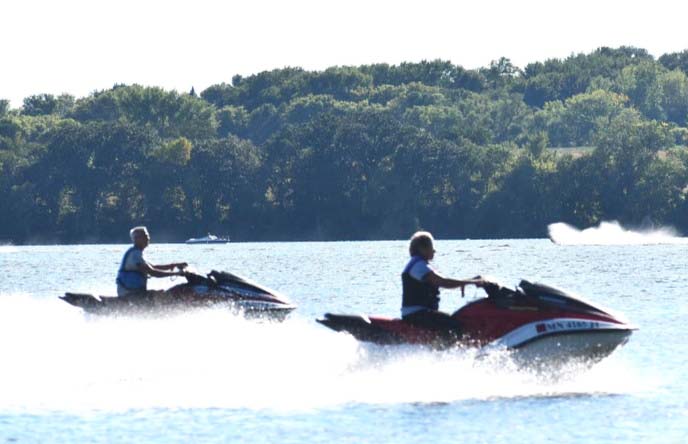New laws in MN target watercraft, motorcycles

ABOVE: Two jetskis zip by on Hall Lake in Fairmont. Some new changes, including a watercraft law, go into effect in Minnesota on July 1. Sentinel file photo.
FAIRMONT – Two new laws go into effect July 1 as a result of the most recent legislative session, targeting watercraft and motorcycles.
The watercraft law will require adult operators to have a valid watercraft operator’s permit. An adult operator is considered to be 12 years old or older. The law will be rolled out gradually.
Starting July 1, 2025, only those born after June 30, 2004 need a permit. This will extend to those born after June 30, 2000 in 2026, June 30, 1996 in 2027, and June 30, 1987 in 2028. There are currently no plans to go further back than that.
DNR Conservation Officer Eric Schettler said if people have taken the operator’s permit course already, that counts as long as they have their physical certificate.
“If they’ve lost their certificate or anything like that, there’s routes they can get that,” he said. “It’s a one-time shot. You don’t have to do it every year. If you pass a certification, you keep the card with you. It’s no different than your driver’s license on your motor vehicle.
Even if one has passed the course, a physical certificate is needed at all times while piloting watercraft for proof.
Schettler said the permit course covers all the safety portions of operating watercraft.
“What buoys are out there, what they mean, the rules and regulations we have now are on that certification,” he said.
The course takes 3 to 4 hours to complete, is fully online, and can be stopped and started at any time. The exam itself for the course costs $34.95.
There have not been any complaints received by Schettler, but he said it’s not impossible there could be some as the law is put in place.
“I imagine there’s going to be a few,” he said. “Because it’s like, ‘Well, I didn’t need it before.’ Well, you do now. You have to comply with the law. The main goal is to educate the public what they can and cannot do safely so watercraft fatalities, injuries, all that stuff goes down.”
As far as penalties go, those 18 or older without a watercraft safety permit will have a base fine of $50 and $85 in court costs. For those under 18, the owner of the watercraft will be charged with allowing illegal operation of a watercraft by a juvenile and pay a $100 fine plus the $85 in court costs.
The second incoming law allows lane splitting and filtering. Both involve motorcycles going between cars, but splitting is when vehicles are in motion while filtering is when they are stopped. Fairmont Police Sergeant Colin Hagert said there will be provisions for how splitting is allowed.
“When a motorcyclist is lane splitting, they have to be going 25 miles an hour or less,” he said. “They cannot be going 15 miles an hour or more faster than the other cars around them.”
As an example, Hagert said if cars are going 5 mph due to a traffic jam or blockage ahead, motorcyclists must go slower than 20 mph while lane splitting. Hagert said there are a few reasons for the allowance of splitting.
“It’s to reduce rear-end collisions,” he said. “It also provides an escape route for motorcyclists to maneuver away from collisions, certain debris in the roadway, whatever it might be. It also is a more efficient use of the road space. With all of that in consideration, it’s going to lead to faster travel times, and I think that makes everybody happy.”
Lane splitting cannot be done at a roundabout, in a school zone, single-lane road work zone, or on a freeway or expressway ramp. It can also only be done when two or more lanes are going in the same direction, which makes splitting possible.
There are also penalties which can be enforced on motorcyclists and automobile drivers.
“The criminal penalties a motorcyclist can get [include] citations for lane splitting inappropriately,” Hagert said. “They can also get other things like reckless driving and careless driving. Same thing goes for the other vehicles. Regular vehicles trying to cut off the motorcyclists purposefully, you can’t do that. We’ve got to all be respectful and in that circumstance, the vehicles can be criminally liable.”
Civil penalties can also be implemented, with severity depending on totality of circumstances and who’s at fault.
As for cars, Hagert recommends staying in the middle of the lane to provide ample space for motorcyclists to lane split.
“Nobody recommends hugging one line over the other,” he said. “The lane has ample room for the vehicle itself, so that will allow ample room for motorcyclists to slide on through.”
In Fairmont, Hagert said motorcyclists are fairly common. He said there thankfully haven’t been many motorcycle incidents, but that it is a more common occurrence in more populated areas.
“The community is just super good looking out for them,” Hagert said. “Now we just got to amp up our attention.”


